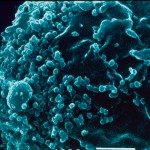Link to Pubmed [PMID] – 18222166
Biochim. Biophys. Acta 2008 Jul-Aug;1778(7-8):1624-39
Membrane fusion and fission underlie two limiting steps of enveloped virus replication cycle: access to the interior of the host-cell (entry) and dissemination of viral progeny after replication (budding), respectively. These dynamic processes proceed mediated by specialized proteins that disrupt and bend the lipid bilayer organization transiently and locally. We introduced Wimley-White membrane-water partitioning free energies of the amino acids as an algorithm for predicting functional domains that may transmit protein conformational energy into membranes. It was found that many viral products possess unusually extended, aromatic-rich pre-transmembrane stretches predicted to stably reside at the membrane interface. Here, we review structure-function studies, as well as data reported on the interaction of representative peptides with model membranes, all of which sustain a functional role for these domains in viral fusion and fission. Since pre-transmembrane sequences also constitute antigenic determinants in a membrane-bound state, we also describe some recent results on their recognition and blocking at membrane interface by neutralizing antibodies.



